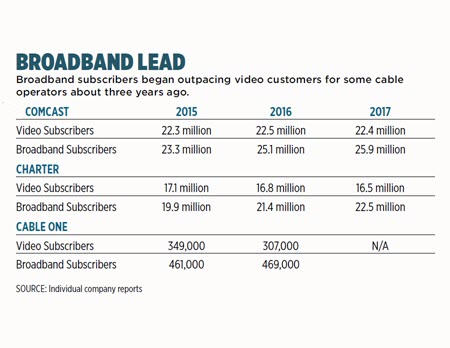Smart TVs, Dumb Pipes

San Antonio, Texas — Over the past few decades one of the worst insults you could hurl at a cable operator was that it sold nothing but a “dumb pipe,” a conduit through which vastly smarter content flowed to increasingly sophisticated hardware.
But today, as broadband has become the business of choice for large and small operators — every publicly traded cable operator has more high-speed data customers than video customers — being a dumb pipe, it seems, isn’t so bad after all.
“The trends in pay TV have been absolutely horrible,” New Street Research managing director Jonathan Chaplin said at the National Cable Television Cooperative’s Winter Educational Conference here. “We’ve seen traditional linear pay TV subscribers falling off a cliff over the course of the last few years at an accelerating rate, and we think this trend continues. We think the economics of pay TV for cable companies are marginal at best.”
Cash-Flow Benefits
He then pointed to Charter Communications and Comcast, which he estimated generate $15 and $24 per month per customer in free cash flow from video, respectively.
“When a household cuts the cord and goes broadband-only, the increase in broadband pricing more than offsets the loss in profitability from the video product,” Chaplin said.
NCTC president Rich Fickle said that while some of the co-op’s members have de-emphasized video, it will likely remain in the cable package for a while. “Video is going to be a part of the equation for a long time,” he said. “It’s an established business, customers like the fact that they’ve got a good local operator that they can trust. It’s going to erode slowly over time.”
And the more that base erodes, the more cable becomes a content conduit. According to Chaplin, that’s not such a bad thing. “There is nothing wrong with being a dumb pipe,” he said. “It’s a magnificent business if there are no other pipes and if everybody wants your pipe.”
That last part might seem like a key caveat, but cable has consistently come out on top in the ongoing broadband wars, accounting for more than 100% of high-speed data customer additions for more than a decade. It seems that barring some unforeseeable calamity — like widespread, reliable and affordable 5G wireless service from telcos — cable will indeed remain the broadband pipe of choice.
Preserving that leadership role will be crucial because Chaplin doesn’t see a lot of video growth for cable operators down the road. “The entire future value of cable is in broadband — 80% of EBITDA, 90% of the enterprise value of these companies over the next few years.”
Some operators have already taken the bold move to de-emphasize video all together. Cable One did it a few years ago, as broadband revenue finally exceeded video revenue for the first time in 2016 ($344.2 million vs. $294.8 million for video). And while the big MSOs still reap a big chunk of revenue from video, the gap is closing. Comcast, the largest cable operator in the country, reported video revenue of $21.5 billion in 2015 and broadband revenue of $12.5 billion. Last year that gap narrowed to $23.1 billion for video, and $14.8 billion for broadband.
Not Too Far to Travel
American Cable Association president and CEO Matt Polka said from that perspective, it isn’t a big leap to just providing access to apps or other content sources.
“What’s wrong with giving the consumer access to go wherever they want to go?” Polka said. “We’re trying to enable all of that, our members are trying to get that choice and control more to the consumer to the extent the content companies allow us to do it.”
Multichannel Newsletter
The smarter way to stay on top of the multichannel video marketplace. Sign up below.
